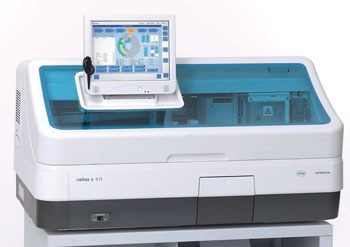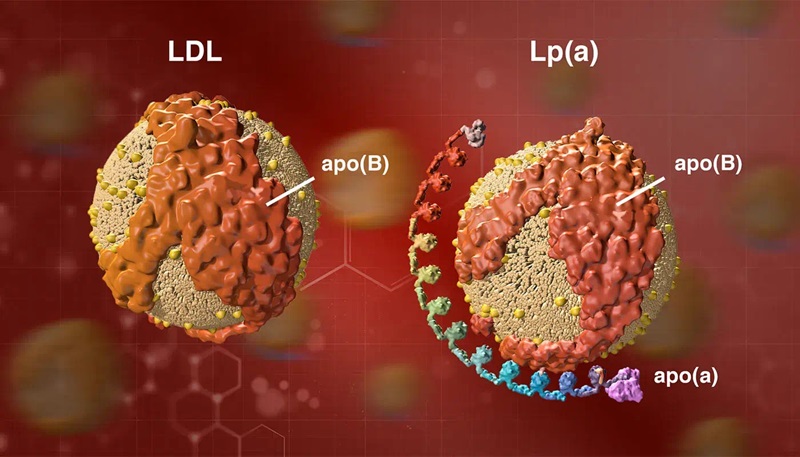Semiautomated Immunoassay for Post-Transplantation Immunosuppressant Assessed
|
By LabMedica International staff writers Posted on 29 Apr 2014 |

Image: cobas e 411 immunoassay analyzers (Photo courtesy of Roche Diagnostics).
Strategies to improve the long-term preservation of organ function and to reduce the incidence of accompanying diseases such as infections, renal insufficiency, cardiovascular disease and malignancy associated with immunosuppression are increasingly important.
Tacrolimus (TAC) is a post-transplantation immunosuppressant drug used in patients for whom careful monitoring of TAC concentration is essential and a new semiautomated immunoassay for TAC measurements is available and has been assessed in a multicenter evaluation.
A team of scientists from Klinikum-Stuttgart (Stuttgart, Germany) examined residual whole blood samples from patients undergoing TAC therapy after organ transplant and were used in assay evaluation at five clinical laboratories in Europe from October 2012 to April 2013. Studies included imprecision within-run and intermediate, functional sensitivity, linearity, and recovery from external quality assessment scheme (EQAS) samples. The assay was compared to liquid chromatography tandem mass spectrometry (LC–MS/MS) used routinely at each investigational site, and to another commercial immunoassay.
The team evaluated the Elecsys Tacrolimus immunoassay which was developed by developed by Roche Diagnostics for use on the cobas e immunoassay analyzers (Basel, Switzerland). The Elecsys Tacrolimus immunoassay uses the principle of electrochemiluminescence for detection and measurement. This assay was compared with in three centers to an immunoassay from Abbott Architect (Abbott Park, IL, USA) and in five centers to LC–MS/MS analysis.
The investigators observed linearity from 0.5 to 40 μg/L and determined a functional sensitivity of 0.3 μg/L. The within-run imprecision was less than 5.1% on cobas e 602 (5.1% at 1.5 μg/L) and less than 8.9% (8.9% at 0.8 μg/L) on cobas e 411. The intermediate imprecision for TAC concentrations equal to or greater than 6.8 μg/L was less than 6.5%. At lower therapeutic concentrations to 1.5 μg/L, it was consistently less than 10%.
The authors concluded that the assay performed well at all investigator sites, implementation and handling were simple, no deviation from the manufacturer insert information regarding calibration and or reagent stability was observed. The Elecsys Tacrolimus assay has good linearity, functional sensitivity and intermediate imprecision and is comparable to LC–MS/MS methods. The over-all performance of electrochemiluminescence immunoassay demonstrates a modern generation TAC assay that meets the demands of monitoring drug concentrations in current immunosuppressive regimens. The study was published on April 12, 2014, in the journal Clinical Biochemistry.
Related Links:
Klinikum-Stuttgart
Roche Diagnostics
Abbott
Tacrolimus (TAC) is a post-transplantation immunosuppressant drug used in patients for whom careful monitoring of TAC concentration is essential and a new semiautomated immunoassay for TAC measurements is available and has been assessed in a multicenter evaluation.
A team of scientists from Klinikum-Stuttgart (Stuttgart, Germany) examined residual whole blood samples from patients undergoing TAC therapy after organ transplant and were used in assay evaluation at five clinical laboratories in Europe from October 2012 to April 2013. Studies included imprecision within-run and intermediate, functional sensitivity, linearity, and recovery from external quality assessment scheme (EQAS) samples. The assay was compared to liquid chromatography tandem mass spectrometry (LC–MS/MS) used routinely at each investigational site, and to another commercial immunoassay.
The team evaluated the Elecsys Tacrolimus immunoassay which was developed by developed by Roche Diagnostics for use on the cobas e immunoassay analyzers (Basel, Switzerland). The Elecsys Tacrolimus immunoassay uses the principle of electrochemiluminescence for detection and measurement. This assay was compared with in three centers to an immunoassay from Abbott Architect (Abbott Park, IL, USA) and in five centers to LC–MS/MS analysis.
The investigators observed linearity from 0.5 to 40 μg/L and determined a functional sensitivity of 0.3 μg/L. The within-run imprecision was less than 5.1% on cobas e 602 (5.1% at 1.5 μg/L) and less than 8.9% (8.9% at 0.8 μg/L) on cobas e 411. The intermediate imprecision for TAC concentrations equal to or greater than 6.8 μg/L was less than 6.5%. At lower therapeutic concentrations to 1.5 μg/L, it was consistently less than 10%.
The authors concluded that the assay performed well at all investigator sites, implementation and handling were simple, no deviation from the manufacturer insert information regarding calibration and or reagent stability was observed. The Elecsys Tacrolimus assay has good linearity, functional sensitivity and intermediate imprecision and is comparable to LC–MS/MS methods. The over-all performance of electrochemiluminescence immunoassay demonstrates a modern generation TAC assay that meets the demands of monitoring drug concentrations in current immunosuppressive regimens. The study was published on April 12, 2014, in the journal Clinical Biochemistry.
Related Links:
Klinikum-Stuttgart
Roche Diagnostics
Abbott
Latest Immunology News
- Blood Test Measures Immune Response to Epstein-Barr Virus in MS Patients
- AI Predicts Tumor-Killing Cells with High Accuracy
- Diagnostic Blood Test for Cellular Rejection after Organ Transplant Could Replace Surgical Biopsies
- AI Tool Precisely Matches Cancer Drugs to Patients Using Information from Each Tumor Cell
- Genetic Testing Combined With Personalized Drug Screening On Tumor Samples to Revolutionize Cancer Treatment
- Testing Method Could Help More Patients Receive Right Cancer Treatment
- Groundbreaking Test Monitors Radiation Therapy Toxicity in Cancer Patients
- State-Of-The Art Techniques to Investigate Immune Response in Deadly Strep A Infections
- Novel Immunoassays Enable Early Diagnosis of Antiphospholipid Syndrome
- New Test Could Predict Immunotherapy Success for Broader Range Of Cancers
- Simple Blood Protein Tests Predict CAR T Outcomes for Lymphoma Patients
- Cell Sorter Chip Technology to Pave Way for Immune Profiling at POC
- Chip Monitors Cancer Cells in Blood Samples to Assess Treatment Effectiveness
- Automated Immunohematology Approaches Can Resolve Transplant Incompatibility
- AI Leverages Tumor Genetics to Predict Patient Response to Chemotherapy
- World’s First Portable, Non-Invasive WBC Monitoring Device to Eliminate Need for Blood Draw
Channels
Molecular Diagnostics
view channel
Novel Technique Detects Novel Biomarkers for Kidney Diseases with Nephritic Syndrome
Nephrotic syndrome is associated with several kidney diseases such as minimal change disease (MCD), primary focal segmental glomerulosclerosis (FSGS), and membranous nephropathy (MN), and is characterized... Read more
Lipoprotein Blood Test Detects Hereditary Cardiovascular Risk
Lipoprotein (a), or Lp(a), is increasingly recognized as a critical but under-acknowledged potential risk factor for cardiovascular diseases, which are a significant public health concern.... Read more
Whole Genome Sequencing Detects Infection Transmission in NICU
A new study has shown that whole genome sequencing (WGS) of bacterial pathogens acquired from surveillance in a neonatal intensive care unit (NICU) can reveal significant infection transmission that goes... Read more
Novel Inexpensive, Shelf-Stable, Easy To Use Tests Bring Lab-Level Precision at POC
One of the most critical measurements in healthcare is the blood cell count, which can provide insights into a range of conditions from infections and autoimmune diseases to cancer. Traditionally, collecting... Read moreHematology
view channel
Next Generation Instrument Screens for Hemoglobin Disorders in Newborns
Hemoglobinopathies, the most widespread inherited conditions globally, affect about 7% of the population as carriers, with 2.7% of newborns being born with these conditions. The spectrum of clinical manifestations... Read more
First 4-in-1 Nucleic Acid Test for Arbovirus Screening to Reduce Risk of Transfusion-Transmitted Infections
Arboviruses represent an emerging global health threat, exacerbated by climate change and increased international travel that is facilitating their spread across new regions. Chikungunya, dengue, West... Read more
POC Finger-Prick Blood Test Determines Risk of Neutropenic Sepsis in Patients Undergoing Chemotherapy
Neutropenia, a decrease in neutrophils (a type of white blood cell crucial for fighting infections), is a frequent side effect of certain cancer treatments. This condition elevates the risk of infections,... Read more
First Affordable and Rapid Test for Beta Thalassemia Demonstrates 99% Diagnostic Accuracy
Hemoglobin disorders rank as some of the most prevalent monogenic diseases globally. Among various hemoglobin disorders, beta thalassemia, a hereditary blood disorder, affects about 1.5% of the world's... Read moreImmunology
view channel
Blood Test Measures Immune Response to Epstein-Barr Virus in MS Patients
Multiple sclerosis (MS) is a chronic neurological condition for which there is currently no cure. It affects around three million people globally and ranks as the second most common cause of disability... Read more.jpg)
AI Predicts Tumor-Killing Cells with High Accuracy
Cellular immunotherapy involves extracting immune cells from a patient's tumor, potentially enhancing their cancer-fighting capabilities through engineering, and then expanding and reintroducing them into the body.... Read more
Diagnostic Blood Test for Cellular Rejection after Organ Transplant Could Replace Surgical Biopsies
Transplanted organs constantly face the risk of being rejected by the recipient's immune system which differentiates self from non-self using T cells and B cells. T cells are commonly associated with acute... Read more
AI Tool Precisely Matches Cancer Drugs to Patients Using Information from Each Tumor Cell
Current strategies for matching cancer patients with specific treatments often depend on bulk sequencing of tumor DNA and RNA, which provides an average profile from all cells within a tumor sample.... Read moreMicrobiology
view channel
Integrated Solution Ushers New Era of Automated Tuberculosis Testing
Tuberculosis (TB) is responsible for 1.3 million deaths every year, positioning it as one of the top killers globally due to a single infectious agent. In 2022, around 10.6 million people were diagnosed... Read more
Automated Sepsis Test System Enables Rapid Diagnosis for Patients with Severe Bloodstream Infections
Sepsis affects up to 50 million people globally each year, with bacteraemia, formerly known as blood poisoning, being a major cause. In the United States alone, approximately two million individuals are... Read moreEnhanced Rapid Syndromic Molecular Diagnostic Solution Detects Broad Range of Infectious Diseases
GenMark Diagnostics (Carlsbad, CA, USA), a member of the Roche Group (Basel, Switzerland), has rebranded its ePlex® system as the cobas eplex system. This rebranding under the globally renowned cobas name... Read more
Clinical Decision Support Software a Game-Changer in Antimicrobial Resistance Battle
Antimicrobial resistance (AMR) is a serious global public health concern that claims millions of lives every year. It primarily results from the inappropriate and excessive use of antibiotics, which reduces... Read morePathology
view channel
AI Tool Detects Tiny Protein Clumps in Microscopy Images in Real-Time
Over 55 million individuals worldwide suffer from dementia-related diseases like Alzheimer's and Parkinson's. These conditions are caused by the clumping together of the smallest building blocks in the... Read more
New Tool Enables Better Classification of Inherited Disease-Causing Variants
Whole genome and exome sequencing are increasingly available for clinical research, aiding in the detection of inherited genetic variants that may cause various diseases. The American College of Medical... Read more
Groundbreaking CRISPR Screen Technology Rapidly Determines Disease Mechanism from Tissues
Thanks to over a decade of advancements in human genetics, scientists have compiled extensive lists of genetic variations linked to a wide array of human diseases. However, understanding how a gene contributes... Read moreTechnology
view channel
New Diagnostic System Achieves PCR Testing Accuracy
While PCR tests are the gold standard of accuracy for virology testing, they come with limitations such as complexity, the need for skilled lab operators, and longer result times. They also require complex... Read more
DNA Biosensor Enables Early Diagnosis of Cervical Cancer
Molybdenum disulfide (MoS2), recognized for its potential to form two-dimensional nanosheets like graphene, is a material that's increasingly catching the eye of the scientific community.... Read more
Self-Heating Microfluidic Devices Can Detect Diseases in Tiny Blood or Fluid Samples
Microfluidics, which are miniature devices that control the flow of liquids and facilitate chemical reactions, play a key role in disease detection from small samples of blood or other fluids.... Read more
Breakthrough in Diagnostic Technology Could Make On-The-Spot Testing Widely Accessible
Home testing gained significant importance during the COVID-19 pandemic, yet the availability of rapid tests is limited, and most of them can only drive one liquid across the strip, leading to continued... Read moreIndustry
view channel
Roche and Hitachi High-Tech Extend 46-Year Partnership for Breakthroughs in Diagnostic Testing
Roche (Basel, Switzerland) and Hitachi High-Tech (Tokyo, Japan) have renewed their collaboration agreement, committing to a further 10 years of partnership. This extension brings together their long-standing... Read more
Danaher and Johns Hopkins University Collaborate to Improve Neurological Diagnosis
Unlike severe traumatic brain injury (TBI), mild TBI often does not show clear correlations with abnormalities detected through head computed tomography (CT) scans. Consequently, there is a pressing need... Read more
Beckman Coulter and MeMed Expand Host Immune Response Diagnostics Partnership
Beckman Coulter Diagnostics (Brea, CA, USA) and MeMed BV (Haifa, Israel) have expanded their host immune response diagnostics partnership. Beckman Coulter is now an authorized distributor of the MeMed... Read more_1.jpg)











